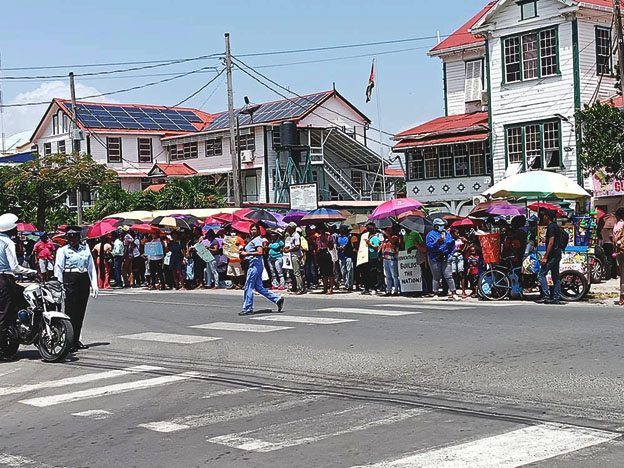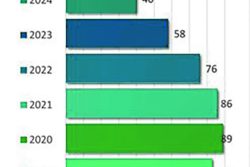Employing phrases ranging in severity from ‘pi..ed off’ to ’frustrated’ ‘(eight children attending state-run secondary schools in Region Four last week expressed to the Stabroek Business their concern over the likelihood of them being unable to fill the tuition gap created by the recently ended protracted teachers’ strike, which will now have to be filled, somehow, prior to the commencement of the Caribbean Examinations Council (CXC) scheduled for mid- next year.
The eight children, members of a single community but attendees of various Secondary Schools in Region Four, all told this newspaper that they were fearful that serious difficulties may now arise in filling the tuition gap created by the absence of teachers from the classroom. One sixteen year-old told the Stabroek Business that while the students are all aware of the fact that in the final analyses it was they who had been left holding the (proverbial) ‘baby,’ in her particular instance, the strike has meant that “there is a whole lot to make up before CXC comes around.”

The strike which commenced in February and lasted for a period of seventy days during which large numbers of children had no access to formal tuition; this lack of access to formal tutoring appears to have created a sense of genuine apprehension among the interviewed children, all of whom clearly believe that the strike had denied them invaluable tuition time CXC.
They pushed the discourse deeper, unanimously expressing the view that the “general conditions” that obtained in the state-run secondary schools that they attended (all in Region Four) do not fill them with confidence that they are not guaranteed graduation from the secondary level equipped to fulfill their ambitions, going forward. Here, there is no hint of animosity towards the strikers, only a sense of appreciation of them having opted to go the extra mile, after their exertions on the picket line. Those students who were unable to access what one member of the group described as “strike time lessons” told the Stabroek Business that they were prepared to “put in the hours” to try to “catch up.”
Two parents of children from the group interviewed by the Stabroek Business told this newspaper that they were concerned that some of the children preparing for the 2025 CXC examinations may face challenges trying to complete the syllabus. That said, they both expressed the view that when account is taken of the disparity between effort and reward on the part of teachers, they could find no fault with the industrial action.
A Georgetown Secondary School teacher with whom the Stabroek Business spoke (entirely separate from the interview with the students) said that since in the absence of teachers from the classroom a ‘thread of discipline was broken’ in terms of ‘direct teacher to pupil delivery’, he opined that there needed to be a post – strike, “settling in period.” That period, he said, could be ‘brief or it could take longer,’ depending on what he described as ‘the mindset of the parties.’ He opined that while a ‘tuition gap’ had been created by the industrial action the fact that “a great many parents were sympathetic to the cause of the strike” had helped to encourage teachers to remain on the picket line. “We, the teachers, owe them a debt of gratitude,” he added.
Asked whether they could identify the particular circumstances that have influenced their present mindset the children all agreed that ‘the general state of instability’ in their present schools’ is by far the biggest factor. Asked to identify the factors that drive the ‘instability’ they agreed that the absence of a generally convivial learning environment was being undermined by general in-school indiscipline and (at the fourth and fifth form levels), insufficient teachers to effectively deliver tuition in all of the subjects at the CXC level, are problems which, according to one female interviewee, “makes an already bad situation worse.”
Attendees at state schools across the country have recently emerged from the experience of a protracted strike by teachers seeking salary increases and while the students were not asked to comment directly on the industrial action each of them, individually, expressed the view that the challenges that inhere in teaching entitle them to salary levels that sufficiently compensate for the extent of their exertions. Contextually, three of the students interviewed by this newspaper said that the physical environment in which both students and teachers at state-run schools had to function were “unacceptable in one respect or another” and to varying degrees. They agreed that in-school physical conditions added significantly to the factors that impede effective education delivery.
One female student, in a vigorous but controlled outburst, told the Stabroek Business that she had grown increasingly concerned over what she felt were the distinct advantages “that have nothing to do with ‘brightness’” that separate some state school attendees from students attending privately run institutions of learning. She expressed the view that this circumstance was likely to show up in performances of the children attending state-run schools as against those who attend privately-run institutions though she agreed that this was not necessarily the case across the board.
When the Stabroek Business’ student interviewees were asked to express their views on the strike which begun in February, and extended over a period in excess seventy days, one student from an East Coast Secondary School declared that the curriculum delivery in the teaching/learning system had been “damaged” by the strike and that it had created “a great deal of anxiety” particularly among those children who were closest to critical examinations, particularly CXC.








